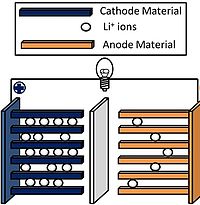
Photo from wikipedia
The number of ions required to drive substrate transport through a secondary active transporter determines the protein’s ability to create a substrate gradient, a feature essential to its physiological function,… Click to show full abstract
The number of ions required to drive substrate transport through a secondary active transporter determines the protein’s ability to create a substrate gradient, a feature essential to its physiological function, and places fundamental constraints on the transporter’s mechanism. Stoichiometry is known for a wide array of mammalian transporters, but, due to a lack of readily available tools, not for most of the prokaryotic transporters for which high-resolution structures are available. Here, we describe a general method for using radiolabeled substrate flux assays to determine coupling stoichiometries of electrogenic secondary active transporters reconstituted in proteoliposomes by measuring transporter equilibrium potentials. We demonstrate the utility of this method by determining the coupling stoichiometry of VcINDY, a bacterial Na+-coupled succinate transporter, and further validate it by confirming the coupling stoichiometry of vSGLT, a bacterial sugar transporter. This robust thermodynamic method should be especially useful in probing the mechanisms of transporters with available structures. DOI: http://dx.doi.org/10.7554/eLife.21016.001
Journal Title: eLife
Year Published: 2017
Link to full text (if available)
Share on Social Media: Sign Up to like & get
recommendations!